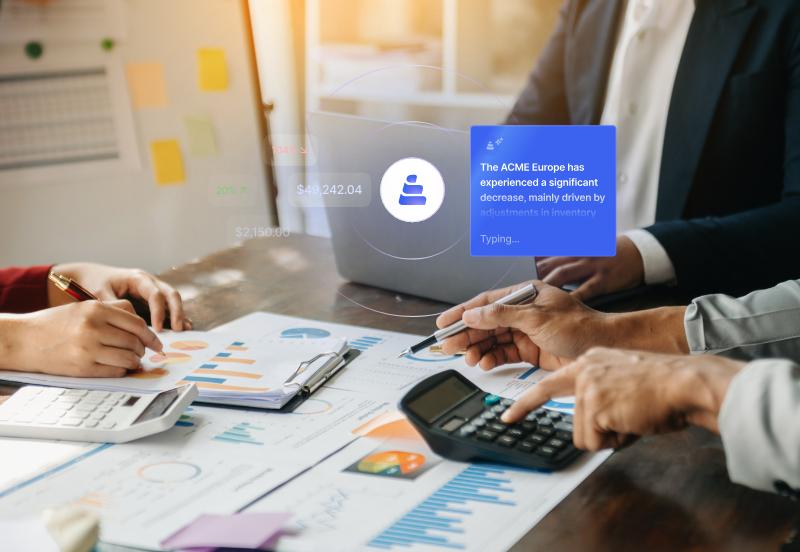
A P&L report, or income statement, summarizes revenues, expenses, and profits over a period. Automating it helps finance teams close faster, reduce errors, and improve visibility, especially across complex, multi-entity environments.
Month-end P&L reporting is one of the most critical outputs of the finance function. It is also one of the most time-consuming and error-prone.
Finance teams routinely spend days consolidating data from multiple systems, checking mappings, building spreadsheets, and troubleshooting anomalies before leadership ever sees a final report. This manual effort adds little value and leaves little time for analysis.
For many companies, the problem is not just volume but fragmentation. Different entities operate on different ERPs. Trial balances arrive at different times.
Account structures are inconsistent. When this complexity is managed manually, P&L reporting becomes a bottleneck that delays close cycles and clouds decision-making.
Automation offers a better path forward. By connecting data across entities, applying rule-based mapping, and generating reports in real-time, finance teams can deliver faster, more accurate results without changing their ERP or sacrificing control.
This is not just a question of speed. It is a way to reduce audit risk, increase transparency, and scale financial operations with confidence.
In this article, we break down how P&L report automation works, what features to look for, and how finance leaders can transition away from manual reporting. Keep reading to learn how to improve speed, accuracy, and visibility in your monthly financials.
What is a P&L Report?
A profit and loss (P&L) report is a financial statement that details a company’s revenue, operating costs, and profit or loss over a defined reporting period. Typically produced monthly, quarterly, or annually, the P&L report is a foundational tool for understanding financial performance.
Finance leaders use P&L reports to analyze operational efficiency, track profit margins, and inform decisions related to budgeting and forecasting. Unlike balance sheets or cash flow statements, which focus on assets or liquidity, the P&L provides a dynamic view of how revenue and expenses interact over time.
What information is included in a P&L report?
A standard P&L report typically includes:
- Revenue or sales
- Cost of goods sold (COGS)
- Gross profit
- Operating expenses (e.g., salaries, rent, marketing)
- Operating income
- Other income or expenses
- Net income (or loss)
Some reports may break this down further by department, entity, product line, or region, depending on the company’s reporting structure.
You might also like: From Spreadsheets to AI: The Evolution of Financial Consolidation
Why Monthly P&L Reports Are Still Done Manually
Despite the availability of advanced financial software, many finance teams still rely on manual processes to generate monthly P&L reports. This is especially common in companies with multiple entities, fragmented systems, or legacy processes.
Manual reporting is often seen as "good enough" because it works, even if it is inefficient and error-prone.
The use of spreadsheets continues because they offer flexibility and familiarity. But that flexibility comes at a cost. As companies scale, manual processes introduce delays, create inconsistencies, and make it harder to maintain data integrity across entities.
When every report depends on tribal knowledge and disconnected files, accuracy and transparency suffer.
What Are the Risks of Manual P&L Reporting?
Manual reporting processes are not only inefficient. They also introduce avoidable financial and compliance risks.
Errors in data consolidation and mapping
When account mapping and data consolidation are performed manually, discrepancies are common. Teams might miss transactions, misclassify expenses, or apply inconsistent logic between periods. These errors distort financial visibility and create downstream issues in budget variance analysis.
Delayed visibility and decision-making
Executives need real-time financial insights to make timely decisions. When reports take weeks to produce, data is already outdated. This lag impacts everything from hiring and spend controls to forecasting and investor communications.
Audit and compliance challenges
Manual reports lack traceability. When auditors request support for a specific number or adjustment, finance teams often scramble to recreate the logic behind the figures. Without a clear audit trail, companies face higher risk exposure, compliance gaps, and wasted time during audit cycles.
Explore more on this topic: AI in Audit: Automating Reconciliations and Financial Reporting
How Does P&L Report Automation Work?
Automating the P&L reporting process replaces spreadsheet-driven workflows with connected, rule-based systems that pull directly from financial data sources.
Automating data consolidation from multiple ERPs
Modern automation tools ingest data from multiple ERPs, trial balances, and ledgers. They standardize disparate formats and unify the data into a single reporting environment. This eliminates the need for offline exports and versioned spreadsheets.
Using rule-based mapping for standardized reporting
Automated reporting platforms use account mapping logic (often defined as reusable rules) to transform raw data into standardized financial categories. This is especially important for companies with a diverse chart of accounts across entities. Rule-based mapping ensures that line items are consistently classified and comparable.
Real-time ledger syncing and data refresh
Automated platforms typically offer near real-time data refreshes. This means that any updates to the general ledger or sub-ledgers are quickly reflected in the reporting layer. Finance teams no longer need to wait days for manual data pulls. This responsiveness enables more agile reporting and mid-month insights.
Generating variance analysis and flux reports automatically
Advanced platforms apply AI to detect significant variances in accounts, flag anomalies, and even generate narrative commentary. Instead of manually comparing period-over-period numbers, users receive AI-generated explanations with drill-down capabilities to the transaction level. These reports support faster root cause analysis and better internal review.
What Are the Benefits of Automating P&L Reports?
The benefits of P&L report automation go beyond time savings. They impact every aspect of financial operations.
Faster monthly close and reduced manual workload
Automated reporting compresses the time it takes to close the books. By eliminating manual consolidation, mapping, and report building, teams can reallocate hours to review and analysis. This not only accelerates the close but also improves its accuracy.
Increased accuracy and audit readiness
Automation reduces human error and enforces consistency in reporting logic. It also maintains a full audit trail of mappings, changes, and approvals. When audits occur, finance teams can easily provide supporting documentation and trace changes back to the source.
Improved visibility across entities and departments
With all financial data centralized and structured, it becomes easier to generate consolidated P&Ls by entity, department, region, or other dimensions. Leadership gains a clearer picture of performance drivers and can take action without waiting on custom spreadsheet builds.
Still building P&L reports in spreadsheets? Download our white paper to learn how automation helps finance teams speed up close, eliminate errors, and deliver audit-ready financials — without switching ERPs.
Key Features to Look for in P&L Report Automation Tools
Not all reporting tools offer true automation. Here are essential features for teams evaluating solutions:
Support for multi-entity and multi-ERP environments
The ability to ingest and unify data from multiple systems is critical for growing or global businesses. Tools should support different currencies, accounting standards, and chart of accounts structures.
AI-powered root cause analysis and variance explanations
Advanced platforms go beyond simple variance flags. Look for tools that offer AI-generated narratives, suggested resolutions, and anomaly detection.
Custom report templates and dimensions
P&L reporting needs vary by stakeholder. Tools should allow finance teams to configure custom templates that reflect internal hierarchies, dimensions, and performance metrics.
Workflow automation for approvals and audit trails
Automated platforms should support collaborative workflows with role-based assignments, version control, and embedded documentation. This improves accountability and simplifies audit preparation.
How to Transition from Manual to Automated P&L Reporting
Moving from manual spreadsheets to automation requires thoughtful planning, but the steps are repeatable.
Steps to evaluate your current reporting process
Start by identifying current pain points. What slows down reporting today? What data is hardest to access? Where are the most common errors or rework areas? Document workflows and dependencies to clarify what needs to change.
What systems need to be connected
List all relevant ERPs, ledgers, and source systems. Determine where data lives and how it currently moves into reports. This assessment will guide the integration scope.
Automate without replacing your ERP
Finance teams can implement P&L report automation without replacing their ERP by using tools that integrate directly with existing systems. These tools connect via APIs or secure file exchanges to pull ledger data, standardize inputs, and generate reports automatically.
This approach avoids the cost, risk, and disruption of a full ERP migration while still delivering the speed and accuracy benefits of automation.
How finance teams can prepare for automation
Successful transitions often begin with standardizing chart of accounts and reporting dimensions. Finance leaders should also prepare their teams to shift from report builders to report reviewers. Training and change management are key to adoption.
Make Monthly P&L Reporting Faster and More Reliable
Automating P&L reports helps finance teams close faster, reduce risk, and gain real-time visibility. It eliminates error-prone manual work and replaces it with consistent, standardized processes that scale.
For finance teams managing multi-entity operations, tools like Nominal support automation across consolidation, close, and reporting without requiring an ERP migration.
By layering intelligent automation on top of existing systems, Nominal helps finance leaders gain control of their reporting process and focus more on analysis, less on assembly.
Learn how Nominal helps you close faster with AI-powered reporting. Book a custom demo.
Still relying on spreadsheets to close the books? Download our white paper to see how finance teams automate consolidations, eliminate intercompany mismatches, and accelerate month-end — all without changing their ERP.





